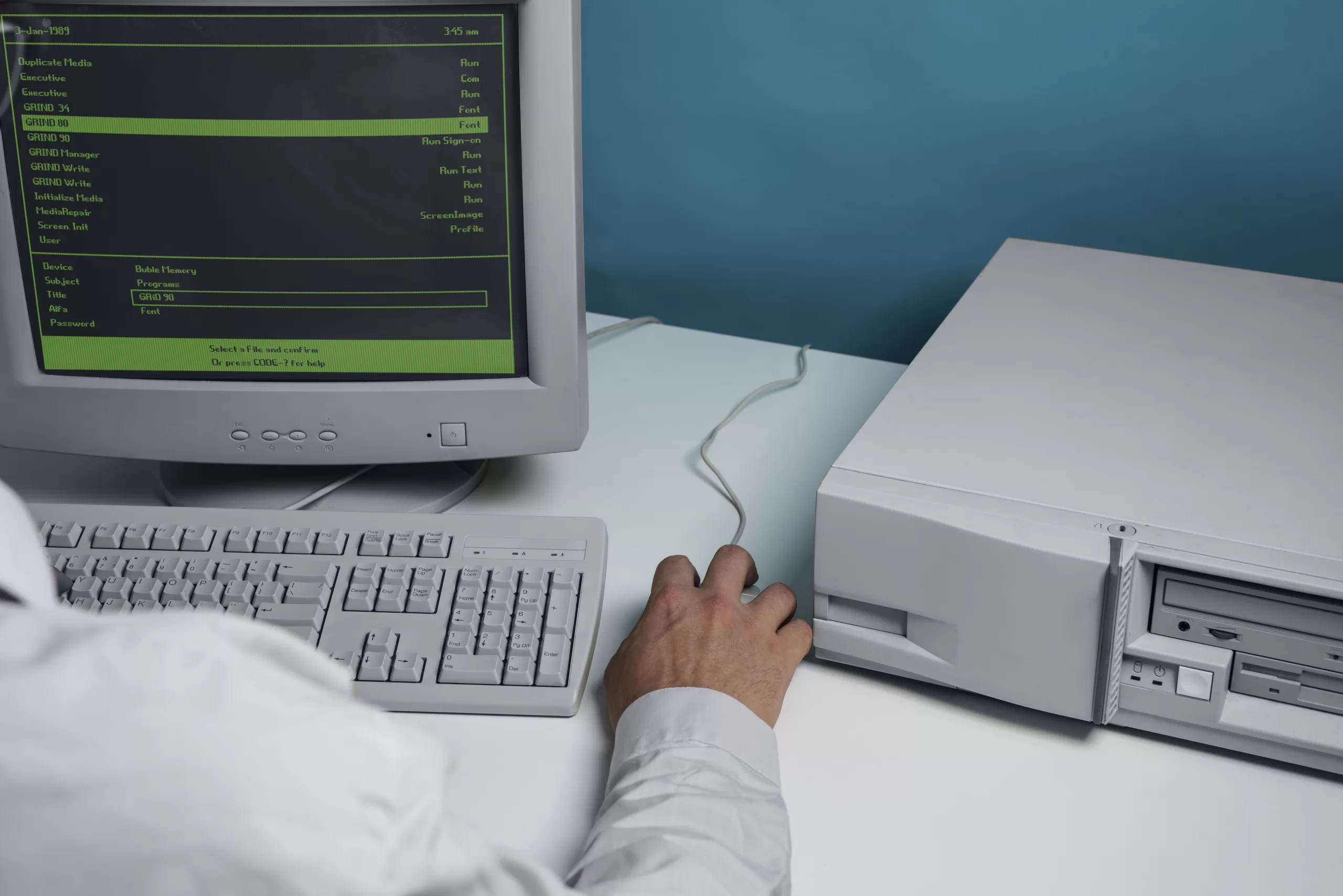Did you know that, according to the SentinelOne Cybersecurity Report (2024), nearly 60% of companies suffered ransomware attacks in 2023, despite investing more and more in security? Seems contradictory, doesn’t it? The problem lies at the root, as many organizations continue operating with outdated technologies that, regardless of how much investment they receive, remain vulnerable.
Digital transformation happens at an impressive speed. What was modern five years ago can now be considered obsolete. Meanwhile, companies that are reluctant to modernize their systems face increasingly greater risks, from security failures to loss of competitiveness.
Let’s get straight to the point! Here are the 7 main risks that your company can no longer ignore if it still depends on outdated technologies. Let’s go?

1. Security vulnerabilities
Outdated systems are like unlocked doors in a house full of valuable objects. The average cost of data breaches reached an all-time high in 2023, reaching $4.45 billion, according to the IBM Healthcare Report (2024), an increase that reflects not only the sophistication of attacks, but also the fragility of poorly protected infrastructures.
Legacy technologies weren’t designed to face modern threats. AI-powered phishing, advanced ransomware, and social engineering attacks exploit exactly these gaps. When a system no longer receives security updates, each newly discovered vulnerability becomes an opportunity for invaders.
The scenario becomes even more concerning when we consider data protection regulations. Fines can reach 2% of the company’s revenue, limited to $50 million per violation in some jurisdictions, and that’s just the beginning. Data breaches destroy customer trust and can take years to overcome.
Companies that invest in intelligent modernization create robust layers of protection that evolve alongside threats. It’s the difference between always being one step behind hackers or anticipating them.
2. Maintenance costs that explode the budget
Here’s a paradox that few managers perceive: maintaining old systems costs much more than modernizing them. The math is cruel, yet simple.
First, there’s the scarcity of professionals. Finding developers who still work with COBOL, AS/400 systems, or old versions of .NET is like looking for a needle in a haystack. When you find them, they charge premium rates for specialized knowledge. Second, vendors stop offering official support, forcing companies to pay exorbitant fees for extended maintenance or seek improvised solutions.
Third, simple problems become complex. A task that would take hours in a modern system can consume days or weeks in an outdated architecture. Each bug becomes an archaeological investigation in the code.
Finally, there’s the opportunity cost. While your team spends 80% of their time “putting out fires” from legacy systems, they stop working on innovations that could generate real revenue. It’s a vicious cycle, because the more time passes, the more expensive it becomes to get out of it.
The initial investment in modernization may seem high, but when compared to the ongoing maintenance costs, it pays for itself in just a few years.
3. Productivity in free fall
Imagine your most talented employees wasting precious hours waiting for reports to be generated, struggling with confusing interfaces, or performing manual tasks that could be automated. This is the reality for companies that insist on legacy technologies.
The frustration is real and measurable. Employees who need to use slow and disintegrated systems lose motivation. They know there are better tools on the market, and they don’t understand why the company doesn’t evolve.
The lack of integration multiplies the problem. Data needs to be copied manually between systems, reports are made in spreadsheets because the main system doesn’t offer decent dashboards, and important decisions are postponed because no one can extract the necessary information quickly.
The cascade effect hits the entire operation. Departments that depend on information from other sectors get stuck. Projects are delayed. Opportunities are lost while more agile competitors advance.
Modern systems don’t just eliminate these bottlenecks, they transform employees into productivity multipliers, capable of focusing on what really matters, which is generating value for the business.

4. Inability to scale the business
Growth should be a reason for celebration, not a nightmare. In companies with outdated systems, each increase in demand becomes an operational crisis.
Black Friday is a perfect example. While competitors take advantage of the sales peak, companies with limited infrastructure see their systems crash exactly when they need to function most. Customers abandon shopping carts, sales are lost, and the company’s reputation gets scratched.
Beyond technical limits, there are functional limitations. Legacy systems were built for business realities that no longer exist. Adding new features or integrating with modern APIs becomes a herculean project, when not impossible.
The result is predictable: companies get trapped in their own technical limitations, watching growth opportunities slip through their fingers.
5. Compromised customer experience
Your customers don’t care if the system you use is from 2005 or 2025. They just want things to work well, quickly, and without complications. When technology fails this basic promise, they simply leave.
Outdated interfaces confuse customers accustomed to the fluidity of modern applications. Processes that should be simple become mazes of unnecessary clicks. Loading times that seemed acceptable a decade ago now generate immediate abandonment.
The situation worsens when we consider digital channels. Customers expect to be able to interact with companies through WhatsApp, social networks, or intelligent chatbots. If your system can’t integrate with these platforms, you automatically offer an inferior experience to the competition.
Customer experience data also becomes fragmented. Without a unified view of interaction history, your agents can’t offer the personalized support that modern consumers expect.
Technological modernization isn’t just about internal efficiency, it’s about creating experiences that delight customers and keep them loyal to your brand.
6. Regulatory compliance at risk
Regulations never stop evolving, especially in the digital age. Laws like GDPR establish specific requirements about how personal data should be collected, stored, and processed. Old systems simply weren’t designed to meet these requirements.
The risk goes beyond direct fines. Fines can reach $20 million per data breach, as we’ve already seen in real cases globally. Audit processes become nightmares when you can’t adequately track the lifecycle of data in your systems.
Regulated sectors face even greater challenges. Banks, healthcare operators, energy companies, all need to demonstrate compliance with specific standards. Legacy systems make this demonstration costly and sometimes impossible.
The data portability issue, provided for in data protection regulations, is a practical example. If a customer requests all the data you have about them, can you quickly extract this information from your old systems? What if they want to delete everything?
Modern technologies are born with native compliance, facilitating audits and reducing regulatory risks. It’s an investment in peace of mind.
7. Interruptions and critical failures
This is the nightmare that keeps any IT manager awake: the company’s main system down for hours or even days. In outdated technologies, this scenario isn’t a question of “if,” it’s a question of “when.”
Old hardware fails without warning. Software without support develops critical bugs that no one knows how to fix anymore. Backups made with obsolete technologies can prove unusable at the moment you need them most.
The cost of downtime goes far beyond revenue lost during the interruption. There’s the cost of recovery, which can involve expensive specialists working 24/7. There’s reputation damage, with customers losing confidence that may never return. And finally, there’s the regulatory cost, as some industries require minimum availability under penalty of fines.
Even worse: legacy systems frequently don’t have robust continuity plans. When they fail, recovery is slow and often incomplete. Important data can be lost forever.
Modernization allows resilient architectures, with automatic redundancy, real-time backup, and rapid recovery. It’s the difference between a small turbulence and a complete disaster.

The solution is closer than you imagine
Do you recognize some of these risks in your company? You’re not alone. Thousands of organizations globally face the same challenges, trapped between the need to modernize and the fear of interrupting critical operations.
This is where NextAge comes in, a company with more than 18 years of experience in technological modernization. Our NextFlow AI methodology revolutionizes the modernization process by combining artificial intelligence with human expertise. AI automates tasks included in legacy system modernization projects, accelerating digital transformation and reducing risks.
Our differential lies in the combination of proprietary methodology + artificial intelligence + experienced developers.
Your new system starts here
The 7 risks we explored cost more than any modernization project. While you’re reading this article, competitors may be gaining competitive advantage by investing in technologies you’re still considering adopting.
The good news is that modernization is currently a safe, fast, and predictable process. It doesn’t need to be a solitary and risky journey.
Want to discover how to modernize your systems intelligently and safely? Talk to our specialists and discover how NextFlow AI can transform your technological challenges into competitive advantages. Receive our free assessment.
👉Discover if your system is outdated with our free test






